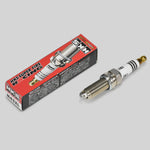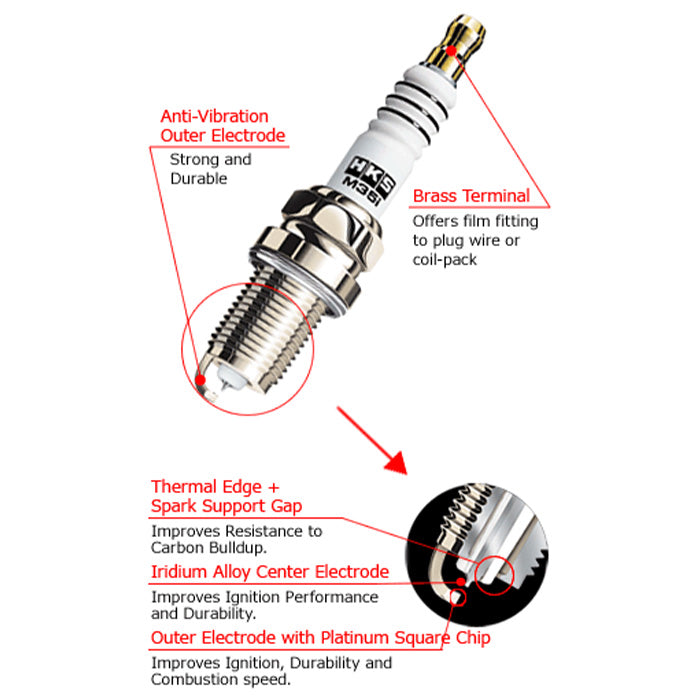
HKS plugs are our go-to choice for spark plugs for all of the Hyundai and Kia engines.
At a NGK Heat Range 9 equivalent, these plugs will ensure there is less heat when you are making more power. We highly recommend this plug when running our Tunes!
Here is a good article on Spark Plug basics by NGK.
HKS Plugs ignite faster for the best fuel efficiency and the best performance in all situations and environments. It is very important to provide safe and stable ignition for the engine to perform at maximum power. HKS Super Fire Racing plug is the best plug for extreme racing driving and also works well for normal tunes.
-
0.6mm Iridium Alloy Center Electrode
Iridium alloy center electrode reduces voltage requirement and improves ignition performance and durability. -
Outer Electrode with Platinum Chip
The outer electrode incorporates a square platinum chip which improves durability, and combining with the iridium center electrode boosts ignition performance.
The outer electrode features a shortened tip design and tapered shape while maintaining the necessary space for proper ignition. -
Short Type Outer Electrode (Anti-Vibration)
The outer electrode has been shortened and engineered with the ideal shape to decrease weight for resistance against vibration. This anti-vibration design improves longevity of the outer electrode. -
Thermal Edge
After long idling or under various combustion conditions, carbon buildup can occur causing misfires. The thermal edge of the ceramic insulator discharges to help decrease carbon deposits. -
Spark Support Gap
Discharge occurs in the spark support gap (space between the tip of insulator and the base of the outer electrode) to help prevent carbon buildup.

Hyundai
- 1.6T 2G CPLT Carbon Fiber Intake (Video)
- 1.6T 2G CPLT Carbon Fiber Intake (PDF)
- 1.6T 2G Carbon Fiber Open Intake (Video)
- 1.6T 2G Carbon Fiber Open Intake (PDF)
- Front Mount Intercooler
- Lower Engine Mount (Video)
- Lower Engine Mount (PDF)
- Oil Catch Can (Dual with -AN Lines) (PDF)
- Oil Catch Can (Dual with RubberLines) (PDF)
- Oil Catch Can (Single with Rubber Lines) (PDF)
- Pierburg Wastegate Solenoid (Video)
- Rear Sway Bar (PDF)
- Resonator Delete Pipe (PDF)
- Shifter Bushings (PDF)
- Shift Knob (PDF)
- Vacuum Distribution Block (PDF)
- 1.6T 2G CPLT Carbon Fiber Intake (Video)
- 1.6T 2G CPLT Carbon Fiber Intake (PDF)
- 1.6T 2G Carbon Fiber Open Intake (Video)
- 1.6T 2G Carbon Fiber Open Intake (PDF)
- Front Mount Intercooler (PDF)
- Lower Engine Mount (Video)
- Lower Engine Mount (PDF)
- Oil Catch Can (Dual with -AN Lines) (PDF)
- Oil Catch Can (Dual with RubberLines) (PDF)
- Oil Catch Can (Single with Rubber Lines) (PDF)
- Pierburg Wastegate Solenoid (Video)
- Rear Sway Bar (PDF) (PDF)
- Resonator Delete Pipe (PDF) (PDF)
- Shifter Bushings (PDF) (PDF)
- Shift Knob (PDF) (PDF)
- Vacuum Distribution Block (PDF)
- Axle Back (Video)
- 1.6T 2G CPLT Carbon Fiber Intake (Video)
- 1.6T 2G CPLT Carbon Fiber Intake (PDF)
- 1.6T 2G Carbon Fiber Open Intake (Video)
- 1.6T 2G Carbon Fiber Open Intake (PDF)
- Front Mount Intercooler (PDF)
- Lower Engine Mount (Video)
- Lower Engine Mount (PDF)
- Manual Transmission Shift Boot (PDF)
- Pierburg Wastegate Solenoid (Video)
- Oil Catch Can (Dual with -AN Lines) (PDF)
- Oil Catch Can (Dual with RubberLines) (PDF)
- Oil Catch Can (Single with Rubber Lines) (PDF)
- Rear Sway Bar (PDF)
- Resonator Delete Pipe (PDF)
- Shifter Bushings (PDF)
- Shift Knob (PDF)
- Vacuum Distribution Block (PDF)
- 1.6T 2G CPLT Carbon Fiber Intake (Video)
- 1.6T 2G CPLT Carbon Fiber Intake (PDF)
- 1.6T 2G Carbon Fiber Open Intake (Video)
- 1.6T 2G Carbon Fiber Open Intake (PDF)
- Front Mount Intercooler (PDF)
- Lower Engine Mount (Video)
- Lower Engine Mount (PDF)
- Manual Trans Cable End Bushings (PDF)
- Manual Trans Shift Boot (PDF)
- Manual Trans Shifter Bushings (PDF)
- Pierburg Wastegate Solenoid (Video)
- Oil Catch Can (Dual with -AN Lines) (PDF)
- Oil Catch Can (Dual with RubberLines) (PDF)
- Oil Catch Can (Single with Rubber Lines) (PDF)
- Rear Sway Bar (PDF)
- Resonator Delete Pipe (PDF)
- Shift Knob (PDF)
- Vacuum Distribution Block (PDF)
Coming Soon!
- Axle-Back Exhaust (Video)
- Axle-Back Exhaust (PDF)
- 1.6T 2G CPLT Carbon Fiber Intake (Video)
- 1.6T 2G CPLT Carbon Fiber Intake (PDF)
- 1.6T 2G Carbon Fiber Open Intake (Video)
- 1.6T 2G Carbon Fiber Open Intake (PDF)
- Front Mount Intercooler (PDF)
- Lower Engine Mount (Video)
- Lower Engine Mount (PDF)
- Manual Trans Cable End Bushings (PDF)
- Manual Trans Shifter Bushings (PDF)
- Pierburg Wastegate Solenoid (Video)
- Rear Sway Bar (PDF)
- Resonator Delete Pipe (PDF)
- Shifter Bushings (PDF)
- Short Ram Intake (PDF)
- Fuel Feed Line (PDF)
- Front Mount Intercooler (PDF)
- Lower Engine Mount (Video)
- Lower Engine Mount (PDF)
- Manual Trans Cable End Bushings (PDF)
- Manual Trans Shifter Bushings (PDF)
- Pierburg Wastegate Solenoid (Video)
- Oil Catch Can (Dual with -AN Lines) (PDF)
- Oil Catch Can (Dual with Rubber Lines) (PDF)
- Oil Catch Can (Single with -AN Lines) (PDF)
- Oil Catch Can (Single with Rubber Lines) (PDF)
- Resonator Delete Pipe (PDF)
- Shift Knob (PDF)
- Vacuum Distribution Block (PDF)
Kia
- 1.6T 2G CPLT Carbon Fiber Intake (Video)
- 1.6T 2G CPLT Carbon Fiber Intake (PDF)
- 1.6T 2G Carbon Fiber Open Intake (Video)
- 1.6T 2G Carbon Fiber Open Intake (PDF)
- Lower Engine Mount (Video)
- Lower Engine Mount (PDF)
- Manual Trans Cable End Bushings (PDF)
- Manual Trans Shifter Bushings (PDF)
- Pierburg Wastegate Solenoid (Video)
- Resonator Delete Pipe (PDF)
- Shift Knob (PDF)
- Single Catch Can Kit (Video)
- Single Catch Can Kit (PDF)
- Vacuum Distribution Block (PDF)
- Dual Oil Catch Can Kit (PDF)
- Front Mount Intercooler Kit (PDF)
- Fuel Feed Line
- Lower Engine Mount (Video)
- Lower Engine Mount (PDF)
- Manual Trans Cable End Bushings (PDF)
- Manual Trans Shifter Bushings (PDF)
- Pierburg Wastegate Solenoid (Video)
- Resonator Delete Pipe (PDF)
- Shift Knob (PDF)
- Single Catch Can Kit (PDF)
- Vacuum Distribution Block (PDF)
Toyota
- Arm Rest (Video)
- CPLT Intake (Video)
- Dual Exit Exhaust (Video)
- Intercooler (Video)
- Lower Engine Mount (Coming Soon)
- Rear Strut Bar (PDF)
- Shifter Bushings (PDF) (Video)
- Single Exit Exhaust (Video)
- Coming Soon!
California Air Resource Board and The U.S. Environmental Protection Agency
The U.S. Environmental Protection Agency set the standard for emissions controls with the Clean Air Act in 1970, but The California Air Resource Board (C.A.R.B.) is becoming the new standard for all emissions controls and vehicle stadards.
"The Clean Air Act (CAA) is the comprehensive federal law that regulates air emissions from stationary and mobile sources. Among other things, this law authorizes EPA to establish National Ambient Air Quality Standards (NAAQS) to protect public health and public welfare and to regulate emissions of hazardous air pollutants." - www.epa.gov
Environment Protection Agency
NAAQS and SIPs
"One of the goals of the Act was to set and achieve NAAQS in every state by 1975 in order to address the public health and welfare risks posed by certain widespread air pollutants. The setting of these pollutant standards was coupled with directing the states to develop state implementation plans (SIPs), applicable to appropriate industrial sources in the state, in order to achieve these standards. The Act was amended in 1977 and 1990 primarily to set new goals (dates) for achieving attainment of NAAQS since many areas of the country had failed to meet the deadlines." - www.epa.gov
Sources of Pollution
"Section 112 of the Clean Air Act addresses emissions of hazardous air pollutants. Prior to 1990, CAA established a risk-based program under which only a few standards were developed. The 1990 Clean Air Act Amendments revised Section 112 to first require issuance of technology-based standards for major sources and certain area sources. "Major sources" are defined as a stationary source or group of stationary sources that emit or have the potential to emit 10 tons per year or more of a hazardous air pollutant or 25 tons per year or more of a combination of hazardous air pollutants. An "area source" is any stationary source that is not a major source.
For major sources, Section 112 requires that EPA establish emission standards that require the maximum degree of reduction in emissions of hazardous air pollutants. These emission standards are commonly referred to as "maximum achievable control technology" or "MACT" standards. Eight years after the technology-based MACT standards are issued for a source category, EPA is required to review those standards to determine whether any residual risk exists for that source category and, if necessary, revise the standards to address such risk." - www.epa.gov
California Air Resource Board
Background
What's under the hood is important to air quality. Automotive emissions account for over 50 percent of all smog-forming pollutants in California. To improve air quality, the California Air Resources Board (ARB) requires vehicle manufacturers to develop engine and emission equipment systems that reduce the specific pollutants that cause California's severe air quality problem. These emission control systems are also required to be proven durable and reliable.
To ensure that these systems operate as designed, California Vehicle Code Section 27156 and the Federal Clean Air Act prohibit modifications that increase motor vehicle emissions. Since if properly designed, most performance modifications do not increase vehicle emissions, these same laws also allow the installation of parts or modifications proven by their manufacturers and the ARB not to increase vehicle emissions.
All aftermarket parts sold in California belong to one of the following four groups:
- Replacement Parts- Replacement Parts Guide
- Legal Add-On or Modified Parts (Executive Order Parts) - Aftermarket Parts Database
- Competition or Racing Use Only Parts - Exemptions for Uncontrolled Vehicles
- Catalytic Converters
The Maryland Department of the Environment has published a list of states adopting the C.A.R.B. standard for emissions. The list provided applies to new vehicles and emissions control.
To file a warranty claim, please fill out the form below
One of our representatives will contact you within 3 business days.
Please note that not every product contains a lifetime warranty. Certain aspects of parts are not warrantied past a specific period of time.
ONLY ITEM DEFECTS ARE WARRANTABLE.
You can find out more about our warranties on our Terms and Conditions page.
Acceptable claims will require the customer to send the affected product to us to be inspected. This process can take between 1-3 weeks, depending on the severity of the condition. The product will be repaired, replaced or refunded at our determination. A repaired or replaced product will be shipped back to the address on file from the original order unless requested otherwise.



